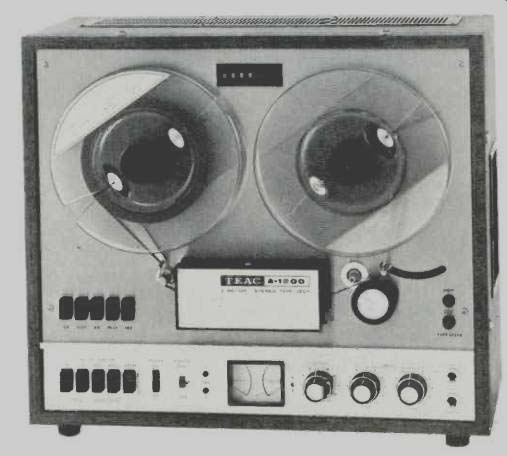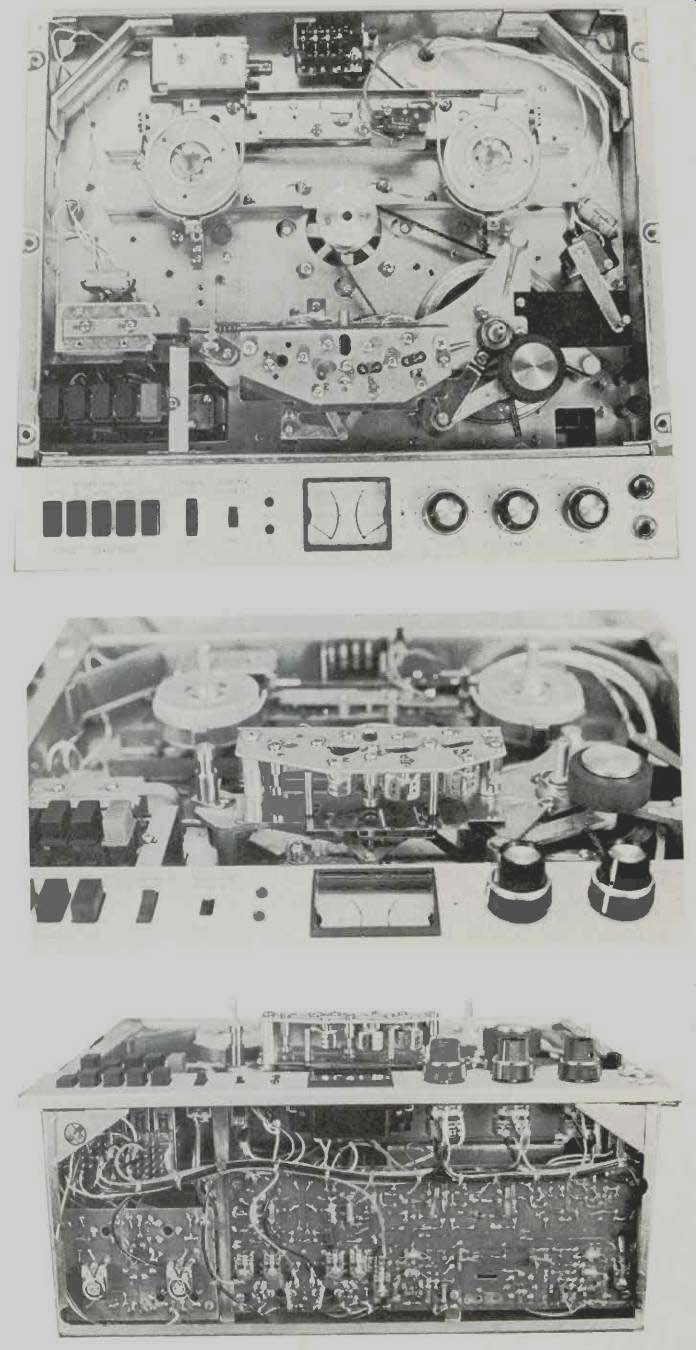 .
.
MANUFACTURER'S SPECIFICATIONS:
Heads: Three 4-track, 2-channel-Erase, Record, Playback.
Tape Speeds: 7 1/2 and 3 3/4 ips.
Motors: Dual-speed hysteresis synchronous motor for capstan drive; two eddy-current outer-rotor motors for reel turntables.
Frequency Response: 7 1/2 ips--30 to 20,000 Hz (±3 dB, 50 to 15,000 Hz); 3 3/4 ips--30 to 15,000 Hz (±3 dB from 50 to 10,000 Hz).
Signal-to-Noise Ratio: 50 dB; Monitoring Headphones: 10,000 ohms, min.
Reel Size: 7 in., maximum.
Wow and Flutter: 7 1/2 ips--0.12%; 3 3/4 ips--0.15%.
Fast-wind time: Approximately 100 sec for 1200 ft.
Crosstalk: 50 dB channel to channel at 1000 Hz; 40 dB between adjacent tracks at 100 Hz.
Inputs: Microphone, 10,000 ohms, 1 mV min.; Line, 10,000 ohms, 0.1 V min. Output: 10,000 ohms min., 1.0 V.
Dimensions: 17" wide x 15 1/2" high x 9 3/4" deep.
Weight: 41 lbs.
Price: $299.50
The three-head deck is becoming more and more popular with the serious recordist over the past year or so in spite of some additional cost. The added expense is, however, justified by the definite advantages offered to the user in his ability to know just what he is getting on the tape during his recording operation--he doesn't have to wait until the end of the selection to find out if all the switches and levers were in the right position. A still more important advantage of the three head configuration is that no compromises must be made in the design .of the heads to make one device do two jobs fairly well. The record head can be made to do the recording job at its best, and more importantly, the gap on the play head can be made smaller in order to give extended frequency response-a most desirable characteristic if the user wants to record at 3 3/4 ips.
While the specifications of the A-1200U are sufficiently impressive in themselves, they are extremely conservative, and they do not tell the whole story of the facilities offered by the machine.
In the first place, the unit is solenoid operated, and a series of push buttons on the front panel control all tape motion.
Another series of buttons provides for selecting channel A or channel B--or both--or a choice of adding channel A to the channel B signal for sound-with-sound recording, or the reverse (channel B to the channel A signal) by depressing either ADD 1 or ADD 2 buttons. In these positions, the playback output from one channel is fed to a mixing network in the opposite channel, with the level of the signal from the tape being controlled by the output level control from its channel. For recording with added echo, both the ADD buttons are depressed at the same time, with the result that the signal from channel B is added to the signal being recorded on channel A with a delay of some 100 milliseconds, and the signal from channel A is delayed and added to the channel B recording. One other button in the series of five of the lower group is a SAFETY, which opens the current supply to the bias/erase oscillator to prevent accidental erasure of any previously recorded material when only playback is wanted.
The front panel is conventional in design, with the usual two reel hubs in the normal positions. At the top center is the 4-digit counter, while at the lower left is the group of pushbuttons which control tape motion-rewind, stop, fast forward, play, and the red record button which must be held down when the play button is depressed to start recording. A spring loaded tension arm keeps the tape against the heads, which have no pressure pads.
The tape then feeds past the capstan and pinch roller, around the automatic shutoff lever, and thence to the takeup reel.
Tape speed is selected by two buttons at the right of the transport panel, and equalization is changed simultaneously with the speed, the latter due to the two speed hysteresis-synchronous motor. Lifters hold the tape away from the heads during fast spooling.

Fig. 2--Showing three different views of the inside of the TEAC A-12000 tape
deck.
The lower section of the panel provides the electronic controls starting with the five pushbuttons previously mentioned for selection of channel, the sound-on sound and echo facilities, and the "safety" button. Next to the right is the power rocker-type switch, followed by the tiny slide switch for selecting tape or source monitoring, and then two small lights showing when the channels are in the record mode. A dual VU meter is next, illuminated when power is on. To the right of the meter are three dual concentric controls with friction clutching between the smaller front knobs (channel A) and the larger rear knobs ( channel B). The first pair controls output level to the LINE OUT phono jacks, the second pair controls recording level from the LINE IN jacks, and the third pair controls recording level from the microphone jacks, which are adjacent to the control.
On the right side of the case is a cutout which gives access to a panel on which are the LINE IN and LINE OUT phono jacks, the stereo phone jack for monitoring, a socket for a remote control accessory ( with a dummy shorting plug in place when the remote control is not in use. There is also a line fuse and a power cord receptacle. Thus in normal use, there are no plugs or cables entering the front panel-only when recording from microphones.
Drive from the capstan motor to the capstan flywheel is by a flat belt, and the spooling motors drive the reel turntables directly. Separate solenoids actuate the pinch roller and the brakes. The d.c. supply to the solenoids, as well as all a.c. to the motors is cut off when the stop button is depressed.
The two identical record amplifiers each employ four transistors-the first is a microphone preamp, followed by a feedback pair, which are in turn followed by a final stage which drives the record head. Record equalization is provided by a resonant circuit across the final-stage emitter resistor, and the values are shifted by the tape-speed relay. Separate volume controls provide for mixing between microphone and line inputs.
The playback amplifiers also use four transistors each, the first two as a feedback pair providing the required equalization, while the remaining two provide additional gain to drive the outputs and the VU meters. The output-level controls affect only the signal at the output jacks, and do not affect the monitoring level to the phones nor the VU meter indications.
The tape-source switch between the two pairs serves to select the monitoring and output signals.
The construction is modular, with the various sections being interconnected by a variety of plugs and sockets. Some are 7-pin tube-type sockets and plugs, others 9-pin types, and a 15-pin rectangular plug and socket is used for most of the non-signal circuits.
Performance
Figure 3 shows the playback response from standard tapes at the two speeds, as well as the record/play response from a flat signal fed to the LINE IN jacks. Note that the response exceeds the specifications appreciably, with the signal down only 2 dB at 22 kHz, and only 7 dB at 24 kHz at 7% ips, while specifications claim only 50 to 15,000 Hz ±3 dB. Thus it is seen that specifications could well be ±1 dB from 40 to 22,000. Similarly, specifications could call for ±1 dB from 50 to 10,000 Hz at 3 3/4 ips, instead of the ±3 dB listed.
Distortion of the standard 3 percent was noted at +7 dB on the VU meter scale, but was only 0.7 percent at the indicated zero level from 100 to 10,000 Hz. Wow and flutter measured .02 percent in the 0.5- to 6-Hz range, at 7 1/2 ips, .06 percent in the range from 6 to 250 Hz, and .07 percent from 0.5 to 250 Hz.
Corresponding figures for 3% ips were .05, .09, and 0.1 percent. Signal-to-noise ratio was 53.5 dB below the 3-percent distortion point, and channel separation measured better than 55 dB at 1000 Hz, with adjacent track separation 48 dB at 100 Hz. Bias-oscillator frequency was measured as 97 kHz. On the whole, these performance figures are all in the excellent category. The input signal required for a 0-VU signal with the record-level controls at maximum was 65 mV, and from the microphone jacks was only 0.1 mV. Line output at the same "0" level was 1.25 V. The unit employs 19 transistors--16 in the four amplifiers, 2 for the bias oscillator, and one as a voltage regulator for the d.c. supply to the record and playback amplifiers.

Fig. 3--Frequency response curves.
With the hysteresis motor, of course, there was no variation in speed over the range from 40 to 80 Hz in the supply, and practically none over an input voltage range from 80 to 135. Rewind and fast forward times were measured at 95 seconds for 1800 feet of tape, though specifications claim 100 sec. for 1200 feet.
The TEAC A-1200 U is easy to thread, simple to operate, and offers most of the features needed by the typical recordist. We could not make it break tape under any condition of operating, but we felt that the reels are so high from the main panel that tape could wrap around the spindles quite easily, particularly if the reels are overly full. But that should be avoided with careful operation--we were only trying to confuse the machine.
-C.G. McP.
=================
(Adapted from Audio magazine, Oct. 1970)
Also see:
TEAC A-7030U Stereo Tape Deck (Feb. 1971)
TEAC 3340 Open-reel tape recorder (Equip. Profile, Mar. 1973)
Wollensak Model 6364 Two/Four Channel Tape Recorder (Equip. Profile, Feb. 1972)
Telex-Viking Quad/Sonic 2 + 2 quadraphonic tape deck (Equip. Profile, Jan. 1972)
Teac X-20R Open-Reel Recorder (Equip. Profile, Mar. 1982)
TEAC Model C-1 Cassette Deck (Dec. 1979)
Technics SV-P100 Digital Audio Cassette Recorder (Apr. 1982)
Technics Model RS-616 Cassette Deck (Feb. 1979)
= = = =